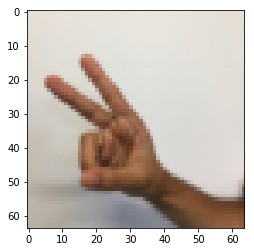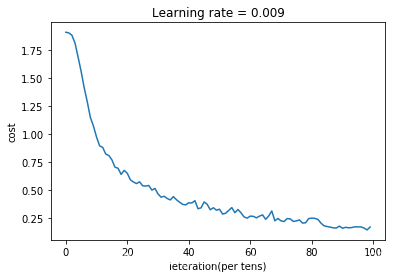吳恩達深度學習4.1練習_Convolutional Neural Networks_Convolution_model_Application_2
阿新 • • 發佈:2018-12-16
版權宣告:本文為博主原創文章,未經博主允許不得轉載。 https://blog.csdn.net/weixin_42432468
學習心得:
1、每週的視訊課程看一到兩遍
2、做筆記
3、做每週的作業練習,這個裡面的含金量非常高。先根據notebook過一遍,掌握後一定要自己敲一遍,這樣以後用起來才能得心應手。
1、Load Dataset
1.1、觀察資料
1.2、資料處理(歸一化、去極值、缺失值處理等)
2、構建優化流圖
2.1、Create Placeholders
2.2、Initialize Parameters
2.3、Forward Propagation
2.4、Compute Cost
2.5、Optimizer
3、初始化變數
tf.global_variables_initializer()
4、優化過程例項化
5、畫圖展示cost變化趨勢
6、Accuracy構建流圖和例項化
import math
import numpy as np
import h5py
import matplotlib.pyplot as plt
import scipy
from PIL import Image
from 1、Load Dataset
1.1、觀察資料
# Loading the data (signs) X_train_orig, Y_train_orig, X_test_orig, Y_test_orig, classes = load_dataset()

index = 6
plt.imshow(X_train_orig[index])
print ('y = ',np.squeeze(Y_train_orig[:,index]))
y = 2

1.2、資料處理(歸一化、去極值、缺失值處理等)
'''
numpy.eye(N,M=None, k=0, dtype=<type 'float'>)
關注第一個第三個引數就行了
第一個引數:輸出方陣(行數=列數)的規模,即行數或列數
第三個引數:預設情況下輸出的是對角線全“1”,其餘全“0”的方陣,如果k為正整數,則在右上方第k條對角線全“1”其餘全“0”,k為負整數則在左下方第k條對角線全“1”其餘全“0”。
'''
a = np.eye(2,dtype=int)
print (a)
[[1 0]
[0 1]]
def convert_to_one_hot(Y, C):
# Y = np.eye(C)[Y.reshape(-1)].T
'函式分解為下面三步'
a = np.eye(C)
a = a[Y.reshape(-1)] # 這一步怎麼理解?
Y = a.T
return Y
# test convert_to_one_hot function
np.random.seed(1)
Y = np.random.randint(0,6,7).reshape(1,7)
print (Y)
Y = convert_to_one_hot(Y,6)
print (Y)
[[5 3 4 0 1 3 5]]
[[0. 0. 0. 1. 0. 0. 0.]
[0. 0. 0. 0. 1. 0. 0.]
[0. 0. 0. 0. 0. 0. 0.]
[0. 1. 0. 0. 0. 1. 0.]
[0. 0. 1. 0. 0. 0. 0.]
[1. 0. 0. 0. 0. 0. 1.]]
X_train = X_train_orig/255
X_test = X_test_orig/255
Y_train = convert_to_one_hot(Y_train_orig,6).T
Y_test = convert_to_one_hot(Y_test_orig,6).T
print ("number of training examples = " + str(X_train.shape[0]))
print ("number of test examples = " + str(X_test.shape[0]))
print ("X_train shape: " + str(X_train.shape))
print ("Y_train shape: " + str(Y_train.shape))
print ("X_test shape: " + str(X_test.shape))
print ("Y_test shape: " + str(Y_test.shape))
number of training examples = 1080
number of test examples = 120
X_train shape: (1080, 64, 64, 3)
Y_train shape: (1080, 6)
X_test shape: (120, 64, 64, 3)
Y_test shape: (120, 6)
2、構建優化流圖
2.1、Create Placeholders
def create_placeholders(n_H0,n_W0,n_C0,n_y):
X = tf.placeholder(tf.float32,shape=[None,n_H0,n_W0,n_C0])
Y = tf.placeholder(tf.float32,shape=[None,n_y])
return X,Y
# test create_placeholders function
X, Y = create_placeholders(64, 64, 3, 6)
print ("X = " + str(X))
print ("Y = " + str(Y))
X = Tensor("Placeholder_2:0", shape=(?, 64, 64, 3), dtype=float32)
Y = Tensor("Placeholder_3:0", shape=(?, 6), dtype=float32)
2.2、Initialize Parameters
def initialize_parameters():
tf.set_random_seed(1)
W1 = tf.get_variable('W1',[4,4,3,8],initializer=tf.contrib.layers.xavier_initializer(seed=0))
W2 = tf.get_variable('W2',[2,2,8,16],initializer=tf.contrib.layers.xavier_initializer(seed=0))
parameters = {"W1": W1,
"W2": W2}
return parameters
# test initialize_parameters function
tf.reset_default_graph()
with tf.Session() as sess_test:
parameters = initialize_parameters()
init = tf.global_variables_initializer()
sess_test.run(init)
print ('W1 = ',parameters['W1'].eval()[1,1,1])
print ('W2 = ',parameters['W2'].eval()[1,1,1])
W1 = [ 0.00131723 0.1417614 -0.04434952 0.09197326 0.14984085 -0.03514394
-0.06847463 0.05245192]
W2 = [-0.08566415 0.17750949 0.11974221 0.16773748 -0.0830943 -0.08058
-0.00577033 -0.14643836 0.24162132 -0.05857408 -0.19055021 0.1345228
-0.22779644 -0.1601823 -0.16117483 -0.10286498]
2.3、Forward Propagation
def forward_propagation(X,parameters):
'''
X -> Z1 -> A1 -> P1 -> Z2 -> A2 -> P2 ->Z3
'''
W1 = parameters['W1']/np.sqrt(2) # 為什麼/np.sqrt(2)效果會更好?
W2 = parameters['W2']/np.sqrt(2)
Z1 = tf.nn.conv2d(X,W1,strides=[1,1,1,1],padding='SAME')
A1 = tf.nn.relu(Z1)
P1 = tf.nn.max_pool(A1,ksize=[1,8,8,1],strides=[1,8,8,1],padding='SAME')
Z2 = tf.nn.conv2d(P1,W2,strides=[1,1,1,1],padding='SAME')
A2 = tf.nn.relu(Z2)
P2 = tf.nn.max_pool(A2,ksize=[1,4,4,1],strides=[1,4,4,1],padding='SAME')
P2 = tf.contrib.layers.flatten(P2)
Z3 = tf.contrib.layers.fully_connected(P2,6,activation_fn=None)
return Z3
# test forward_propagation function
tf.reset_default_graph()
with tf.Session() as sess:
np.random.seed(1)
X,Y = create_placeholders(64,64,3,6)
parameters = initialize_parameters()
Z3 = forward_propagation(X,parameters)
init = tf.global_variables_initializer()
sess.run(init)
a = sess.run(Z3, feed_dict={X: np.random.randn(2,64,64,3), Y: np.random.randn(2,6)})
print ('Z3 = ',a)
'''
此處跟課後答案有些不同,是因為我們使用的TensorFlow版本不同而已
'''
Z3 = [[ 0.63031745 -0.9877705 -0.4421346 0.05680432 0.5849418 0.12013616]
[ 0.43707377 -1.0388098 -0.5433439 0.0261174 0.57343066 0.02666192]]
2.4、Compute Cost
def compute_cost(Z3,Y):
cost = tf.reduce_mean(tf.nn.softmax_cross_entropy_with_logits(logits=Z3,labels=Y))
return cost
# test copute_cost function
tf.reset_default_graph()
with tf.Session() as sess:
np.random.seed(1)
X,Y = create_placeholders(64,64,3,6)
parameters = initialize_parameters()
Z3 = forward_propagation(X,parameters)
cost = compute_cost(Z3,Y)
init = tf.global_variables_initializer()
sess.run(init)
a = sess.run(cost,feed_dict={X: np.random.randn(4,64,64,3), Y: np.random.randn(4,6)})
print ('cost =',a)
cost = 2.2026021
2.5、Optimizer
3、初始化變數
tf.global_variables_initializer()
4、優化過程例項化
5、畫圖展示cost變化趨勢
6、Accuracy構建流圖和例項化
def random_mini_batches(X, Y, mini_batch_size = 64, seed = 0):
"""
Creates a list of random minibatches from (X, Y)
Arguments:
X -- input data, of shape (input size, number of examples) (m, Hi, Wi, Ci)
Y -- true "label" vector (containing 0 if cat, 1 if non-cat), of shape (1, number of examples) (m, n_y)
mini_batch_size - size of the mini-batches, integer
seed -- this is only for the purpose of grading, so that you're "random minibatches are the same as ours.
Returns:
mini_batches -- list of synchronous (mini_batch_X, mini_batch_Y)
"""
m = X.shape[0] # number of training examples
mini_batches = []
np.random.seed(seed)
# Step 1: Shuffle (X, Y)
permutation = list(np.random.permutation(m))
shuffled_X = X[permutation,:,:,:]
shuffled_Y = Y[permutation,:]
# Step 2: Partition (shuffled_X, shuffled_Y). Minus the end case.
num_complete_minibatches = math.floor(m/mini_batch_size) # number of mini batches of size mini_batch_size in your partitionning
for k in range(0, num_complete_minibatches):
mini_batch_X = shuffled_X[k * mini_batch_size : k * mini_batch_size + mini_batch_size,:,:,:]
mini_batch_Y = shuffled_Y[k * mini_batch_size : k * mini_batch_size + mini_batch_size,:]
mini_batch = (mini_batch_X, mini_batch_Y)
mini_batches.append(mini_batch)
# Handling the end case (last mini-batch < mini_batch_size)
if m % mini_batch_size != 0:
mini_batch_X = shuffled_X[num_complete_minibatches * mini_batch_size : m,:,:,:]
mini_batch_Y = shuffled_Y[num_complete_minibatches * mini_batch_size : m,:]
mini_batch = (mini_batch_X, mini_batch_Y)
mini_batches.append(mini_batch)
return mini_batches
# test random_mini_batches function
minibatches_test = random_mini_batches(X_train, Y_train, 64, 1)
minibatch_test = minibatches_test[1]
(X_test,Y_test) = minibatch_test
print (X_test[1,1,1])
[0.90980392 0.87843137 0.85098039]
def model(X_train, Y_train, X_test, Y_test, learning_rate = 0.009,
num_epochs = 100, minibatch_size = 64, print_cost = True):
tf.reset_default_graph()
tf.set_random_seed(1)
seed = 3
(m,n_H0,n_W0,n_C0) = X_train.shape
n_y = Y_train.shape[1]
costs = []
X,Y = create_placeholders(n_H0,n_W0,n_C0,n_y)
parameters = initialize_parameters()
Z3 = forward_propagation(X,parameters)
cost = compute_cost(Z3,Y)
# 2.5、Optimizer
optimizer = tf.train.AdamOptimizer(learning_rate=learning_rate).minimize(cost)
# 3、初始化變數
init = tf.global_variables_initializer()
# 4、優化過程例項化流圖
with tf.Session() as sess:
sess.run(init)
for epoch in range(num_epochs):
minibatch_cost = 0
num_minibatches = int(m/minibatch_size)
seed = seed +1
minibatches = random_mini_batches(X_train, Y_train, minibatch_size, seed)
for minibatch in minibatches:
(minibatch_X,minibatch_Y) = minibatch
_,temp_cost = sess.run([optimizer,cost],feed_dict={X:minibatch_X,Y: minibatch_Y})
minibatch_cost +=temp_cost/num_minibatches
if print_cost == True and epoch%5 ==0:
print('cost after epoch %i:%f'%(epoch,minibatch_cost))
if print_cost == True and epoch%1 == 0:
costs.append(minibatch_cost)
# 5、畫圖展示cost變化趨勢
plt.plot(np.squeeze(costs))
plt.ylabel('cost')
plt.xlabel('ieteration(per tens)')
plt.title('Learning rate = '+ str(learning_rate))
plt.show()
# 6、Accuracy構建流圖和例項化
# 6.1 構建Accuracy流圖
predict_op = tf.argmax(Z3,1)
'''
tf.argmax(vector, 1):返回的是vector中的最大值的索引號,
如果vector是一個向量,那就返回一個值,如果是一個矩陣,那就返回一個向量,
這個向量的每一個維度都是相對應矩陣行的最大值元素的索引號
'''
correct_prediction = tf.equal(predict_op,tf.argmax(Y,1))
accuracy = tf.reduce_mean(tf.cast(correct_prediction,'float'))
'''
tf.reduce_mean(input_tensor, axis=None, keep_dims=False, name=None, reduction_indices=None)
根據給出的axis在input_tensor上求平均值。除非keep_dims為真,axis中的每個的張量秩會減少1。如果keep_dims為真,
求平均值的維度的長度都會保持為1.如果不設定axis,所有維度上的元素都會被求平均值,並且只會返回一個只有一個元素的張量。
'''
'''
cast(x,dtype,name=None)
將x的資料格式轉化成dtype.例如,原來x的資料格式是bool,
那麼將其轉化成float以後,就能夠將其轉化成0和1的序列
'''
# 6.2 Accuracy流圖例項化
train_accuracy = accuracy.eval(feed_dict={X: X_train,Y: Y_train})
test_accuracy = accuracy.eval(feed_dict={X: X_test,Y: Y_test})
'''
Tensor.eval(feed_dict=None, session=None):
作用: 在一個Seesion裡面“評估”tensor的值(其實就是計算),首先執行之前的所有必要的操作來產生這個計算這個tensor
需要的輸入,然後通過這些輸入產生這個tensor。在激發tensor.eval()這個函式之前,tensor的圖必須已經投入到session
裡面,或者一個預設的session是有效的,或者顯式指定session.
引數:feed_dict:一個字典,用來表示tensor被feed的值(聯絡placeholder一起看)
session:(可選) 用來計算(evaluate)這個tensor的session.要是沒有指定的話,那麼就會使用預設的session。
返回: 表示“計算”結果值的numpy ndarray
'''
print ('Train Accuracy :',train_accuracy)
print ('Test Accuracy :',test_accuracy)
return train_accuracy,test_accuracy,parameters
_, _, parameters = model(X_train, Y_train, X_test, Y_test)
cost after epoch 0:1.906084
cost after epoch 5:1.554747
cost after epoch 10:0.971529
cost after epoch 15:0.767831
cost after epoch 20:0.648505
cost after epoch 25:0.536914
cost after epoch 30:0.463869
cost after epoch 35:0.440091
cost after epoch 40:0.385492
cost after epoch 45:0.392317
cost after epoch 50:0.327990
cost after epoch 55:0.296814
cost after epoch 60:0.266418
cost after epoch 65:0.238285
cost after epoch 70:0.224210
cost after epoch 75:0.223669
cost after epoch 80:0.248607
cost after epoch 85:0.173516
cost after epoch 90:0.158102
cost after epoch 95:0.170466

Train Accuracy : 0.94166666
Test Accuracy : 0.953125
# 為什麼test Accuracy不一樣呢?
